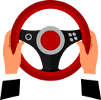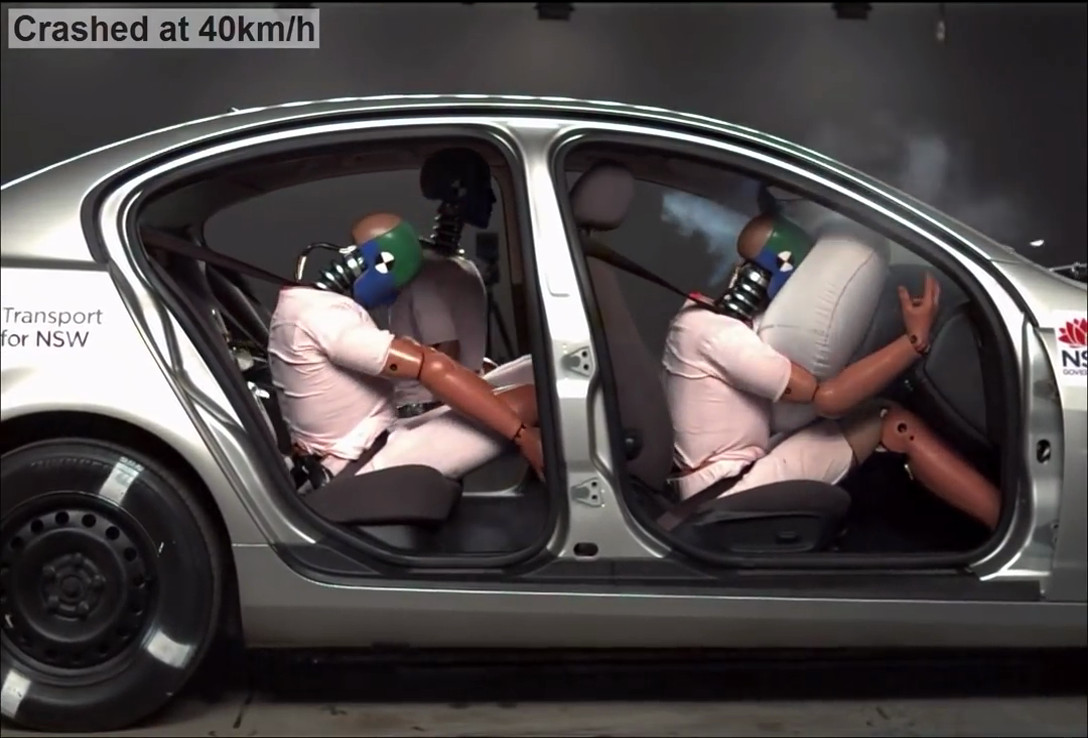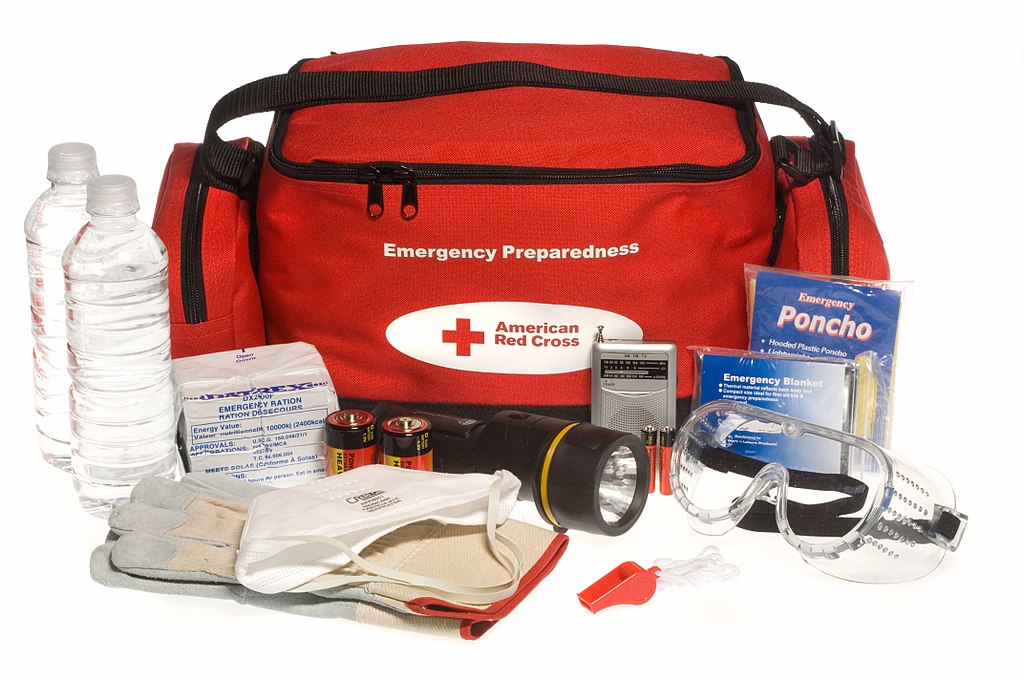
Here you can study for the exam. Look up keywords and learn definitions about all kind of subjects.
Newer vehicles are usually equipped with an 'Antilock Braking System' (abs). Refer to your vehicle manual for more information on how to use abs. The abs system ensures that you can stop the vehicle without slipping. The abs system comes into operation when you have to stop very quickly and press the brake pedal hard.
The airbag is inflated very quickly with a collision or heavy impact. The airbag forms a protective cushion and helps the passengers against injuries.
 © Wikimedia.org/Transport For NSW, CC BY-SA
© Wikimedia.org/Transport For NSW, CC BY-SA
A fire extinguisher is an active fire protection device used to extinguish or control small fires, often in emergency situations. It is not intended for use on an out-of-control fire, such as one which has reached the ceiling, endangers the user (i.e., no escape route, smoke, explosion hazard, etc.), or otherwise requires the expertise of a fire brigade. Typically, a fire extinguisher consists of a hand-held cylindrical pressure vessel containing an agent that can be discharged to extinguish a fire.
A first aid kit is a collection of supplies and equipment that is used to give medical treatment. There is a wide variation in the contents of first aid kits based on the knowledge and experience of those putting it together, the differing first aid requirements of the area where it may be used and variations in legislation or regulation in a given area.
 © Wikimedia.org/Red Cross, CC0
© Wikimedia.org/Red Cross, CC0
A child restraint system is a seat designed specifically to protect children from injury or death during vehicle collisions. Most commonly these seats are purchased and installed by car owners, but car manufacturers may integrate them directly into their vehicle's design and generally are required to provide anchors and ensure seat belt compatibility.
An emergency exit in a structure is a special exit for emergencies such as a fire: the combined use of regular and special exits allows for faster evacuation, while it also provides an alternative if the route to the regular exit is blocked by fire.
An emergency hammer is a safety device used in vehicles or buildings to break through window glass in an emergency. Many are attached to a cable or an alarm device to deter theft or vandalism. It is a simple tool with a plastic handle and steel tips. Its primary use is for breaking through vehicle windows and vertical glazing, which are often tempered, in the event of a crash which prevents exit through the doors.
The 'Electronic Stability Program' (esp) helps the driver to control the vehicle when it is in a critical situation. A microcomputer checks the signals from the esp sensors and checks 25 times per second whether the driver's steering input matches the actual direction in which the vehicle is traveling. When the vehicle is moving in a different direction, esp detects the critical situation and reacts immediately. It uses the vehicle's braking system to stabilize the vehicle. Esp will brake the wheels individually so that the vehicle is stabilized and steered in the right direction.
A Global Positioning System, also known as gps, is a system designed to help navigate on the Earth, in the air, and on water.
Handsfree is an English term that indicates that a device can be operated without the use of the hands. It is mostly used in the sense of mobile telephony in the car. The counterpart is handheld, a device is held in the hand during operation.
A motorcycle helmet is a type of helmet used by motorcycle riders. The primary goal of a motorcycle helmet is motorcycle safety – to protect the rider's head during impact, thus preventing or reducing head injury and saving the rider's life. Some helmets provide additional conveniences, such as ventilation, face shields, ear protection, intercom.
A rear-view mirror is a flat mirror in automobiles and other vehicles, designed to allow the driver to see rearward through the vehicle's rear window (rear windshield).
A runaway truck ramp is a traffic device that enables vehicles which are having braking problems to safely stop. It is typically a long, sand- or gravel-filled lane connected to a steep downhill grade section of a main road, and is designed to accommodate large trucks or buses. The ramp allows a moving vehicle's kinetic energy to be dissipated gradually in a controlled and relatively harmless way, helping the operator to stop it safely without a violent crash.
To improve the safety of the passengers and the driver, there are a number of safety systems in your vehicle. Below you will find the most important ones.
 © Wikimedia.org/Transport For NSW, CC BY-SA
© Wikimedia.org/Transport For NSW, CC BY-SA
Anyone who participates in a passenger car in traffic must always wear the seatbelt or be protected by an adapted and approved security system, such as a carrycot or child seat.
 © Wikimedia.org/Jusmar, CC0
© Wikimedia.org/Jusmar, CC0
Sunglasses are a form of protective eyewear designed primarily to prevent bright sunlight. When driving a vehicle, particularly at high speed, dazzling glare caused by a low Sun, or by lights reflecting off snow, puddles, other vehicles, or even the front of the vehicle, can be lethal. Sunglasses can protect against glare when driving. Two criteria must be met: vision must be clear, and the glasses must let sufficient light get to the eyes for the driving conditions. General-purpose sunglasses may be too dark, or otherwise unsuitable for driving.
The two-second rule is a rule of thumb by which a driver may maintain a safe trailing distance at any speed. The rule is that a driver should ideally stay at least two seconds behind any vehicle that is directly in front of his or her vehicle. It is intended for automobiles, although its general principle applies to other types of vehicles. Some areas recommend a three-second rule instead of a two-second rule to give an additional buffer. The two seconds is not a guide to safe stopping distance, it is more a guide to reaction times.

Help us promote traffic rules on the internet, together we can make the public road safer for everyone. Post a comment or share on social media!
Thank you for providing such clear and detailed information about traffic laws on your website.
I appreciate the effort you’ve put into ensuring road safety awareness. Keep up the great work!!!!
Great resource on fuel types and driving in Hungary—very informative! If you're exploring electric car options in Pakistan, check out https://www.gari.pk/electric-cars-in-pakistan/
THANK YOU SO MUCH FOR YOUR MAKING US HELPFUL FOR DRIVING AND TRAFFIC SIGNS UCTUALY IT WAS IMPORTANT FOR ME TO GET THAT
Hi am a Sierra leonean wishing to have a Driving job in Australia. I can drive any truck from states to states with an up to date Driver's license
The site is very broken images are not loading in and the images do not change after I guess correctly, do better.
Basic Traffic Rules Obey Traffic Signals and Signs – Follow stop signs, yield signs, and traffic lights. Drive on the Right/Left Side – Follow your country’s rule (e.g., right side in the U.S., left side in the U.K.). Use Indicators – Always signal when turning or changing lanes. Follow Speed Limits – Drive within posted speed limits and adjust for weather conditions. Stop for Pedestrians – Yield at crosswalks and school zones. Do Not Drink and Drive – Driving under the influence is illegal and dangerous. Wear Seatbelts – Both drivers and passengers should wear seatbelts at all times. No Mobile Phone Use – Avoid texting or calling while driving unless hands-free. Keep a Safe Distance – Maintain a safe following distance from the vehicle ahead. Yield to Emergency Vehicles – Move aside for ambulances, fire trucks, and police cars with sirens on.
Pleased to say I got 92% even including a couple of stupid mistakes as I have driven in the US at least 3 separate visits.
More community